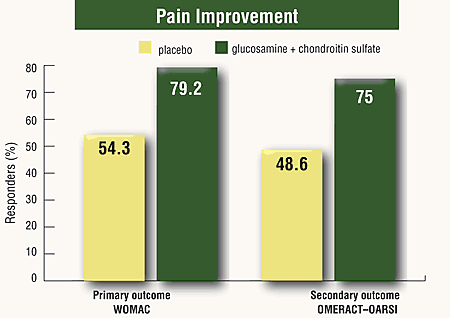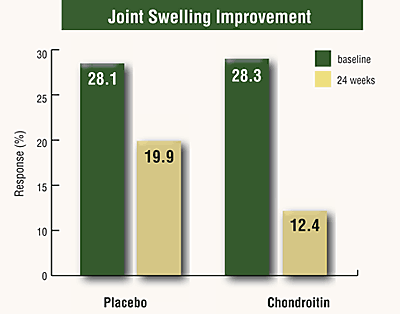Chondroitin sulfate combo effective in moderate-to-severe pain
Joint swelling in GAIT decreased significantly after patients received chondroitin sulfate.
|
A combination of chondroitin sulfate and glucosamine significantly improved pain among patients with moderate-to-severe pain related to knee osteoarthritis, although an overall analysis found no significant differences between treatments and placebo.
Researchers, led by Daniel O. Clegg, MD, observed the improvement in a subgroup analysis of the Glucosamine/chondroitin Arthritis Intervention Trial (GAIT). GAIT results appeared in The New England Journal of Medicine.1
Analysis of secondary outcomes revealed a significant improvement in joint swelling among patients randomly assigned to receive chondroitin sulfate.
GAIT
GAIT was a 24-week, randomized, double-blind, placebo- and positive-controlled, multicenter study. Clegg and colleagues undertook the study to evaluate the efficacy and safety of chondroitin sulfate, glucosamine and a combination of the two. Chondroitin sulfate used alone or with glucosamine was provided by Bioiberica. A previous meta-analysis evaluating chondroitin sulfate and glucosamine suggested a potential benefit for the supplements.2
All patients in the study had clinical and radiographic evidence of knee osteoarthritis. Patients were randomly assigned to one of five treatments: 500 mg of oral glucosamine three times daily (n=317), 400 mg of oral chondroitin sulfate three times daily (n=318), 500 mg of oral glucosamine plus 400 mg of chondroitin sulfate three times daily (n=317), placebo (n=313), or 200 mg of celecoxib (Celebrex, Pfizer) daily as a positive control (n=318).
Patients were stratified according to baseline Western Ontario and McMaster Universities Osteoarthritis Index (WOMAC) scores. Pain scored as 125 to 300 was considered mild, and pain of 301 to 400 was considered moderate to severe. There were 354 patients with moderate-to-severe pain.
A 20% decrease in the summed WOMAC pain score from baseline to week 24 was considered a response to treatment. Clegg and colleagues also used response criteria from the Outcome Measures in Rheumatology Clinical Trials (OMERACT) and the Osteoarthritis Research Society International (OARSI) task force.3 Secondary outcomes included the WOMAC stiffness and function scores and presence or absence of soft-tissue swelling in the more symptomatic knee.
Overall, however, differences between treatment and placebo were small for both WOMAC and OMERACT-OARSI response, according to the GAIT results. Among the entire patient population, glucosamine and chondroitin sulfate, alone or in combination, did not significantly improve outcomes, compared with placebo. The findings were similar for patients with mild pain.
Moderate-to-severe pain
Analysis of patients with moderate-to-severe pain found that combination therapy significantly decreased knee pain, although the overall analysis did not demonstrate statistical differences, according to Clegg. The researchers said the finding was interesting but needed to be confirmed by another trial.
|
Figure 1. The percentage of patients with moderate-to-severe pain who experienced a decrease in pain was significantly better among those who received the combination treatment vs. placebo (P = .002 for WOMAC; P = .001 for OMERACT-OARSI).1 |
The combination of chondroitin sulfate and glucosamine led to 24.9% higher response rate than placebo (P = .002), according to WOMAC criteria (Figure 1). Responses were also significantly better with the combination than placebo, according to OMERACT-OARSI criteria: 26.4% higher (P = .001).
The other treatments did not produce a significantly better response than placebo, according to WOMAC or OMERACT-OARSI criteria. Patients who received chondroitin sulfate experienced a 7.1% improvement according to WOMAC (P = .39) and a 10% improvement according to OMERACT-OARSI (P = .24). The lack of significance for individual treatments may be caused by study limitations.
Study limitations
The study had several limitations. The researchers’ ability to detect benefits of the active treatments may have been hampered by both the relatively mild degree of osteoarthritis-related pain among the participants and the high rate of response to placebo. Other trials have reported similar placebo responses.4,5
Clegg and colleagues hypothesized that the placebo response may be partly caused by patient biases and expectations.
The mild degree of osteoarthritis-related pain may have made it difficult for the researchers to identify improvement as most outcome measures for osteoarthritis treatment may be insensitive to changes in patients with mild symptoms. As expected, the OMERACT-OARSI response outcome was the best method for identifying improvement in these patients.
Although treatment effects were more easily identified among patients with moderate-to-severe pain, the number of patients in this subgroup was small, which may have limited the study’s ability to find significant differences among treatment groups.
Other findings
Among all patients, chondroitin sulfate significantly improved joint swelling, effusion or both on clinical examination (Figure 2). At baseline, 28.3% of patients who received chondroitin sulfate experienced joint swelling. At the end of follow-up, joint swelling was present in 12.4% of patients (P = .01). Celecoxib also led to a significant improvement in joint swelling.
|
|
Figure 2. Joint swelling improved with chondroitin sulfate over the course of GAIT compared with placebo (P = .01).1 |
References
- Clegg DO, Reda DJ, Harris CL, et al. Glucosamine, chondroitin sulfate, and the two in combination for painful knee osteoarthritis. N Engl J Med. 2006;354:795-808.
- McAlindon TE, LaValley MP, Gulin JP, Felson DT. Glucosamine and chondroitin for treatment of osteoarthritis: a systematic quality assessment and meta-analysis. JAMA. 2000;283:1469-1475.
- Pham T, van der Heijde D, Altman RD, et al. OMERACT-OARSI initiative: Osteoarthritis Research Society International set of responder criteria for osteoarthritis clinical trials revisited. Osteoarthritis Cartilage. 2004;12:389-399.
- Altman RD, Moskowitz R. Intraarticular sodium hyaluronate (Hyalgan) in the treatment of patients with osteoarthritis of the knee: a randomized clinical trial. J Rheumatol. 1998;25:2203-2212.
- Lehmann R, Brzosko M, Kopsa P, et al. Efficacy and tolerability of lumiracoxib 100 mg once daily in knee osteoarthritis: a 13-week, randomized, double-blind study vs. placebo and celecoxib., Curr Med Res Opin. 2005;21:517-526.

![Daniel O. Clegg, MD [photo]](/~/media/images/news/print/orthopedics-today/2006/05_may/clegg_70_90_16706.jpg)

